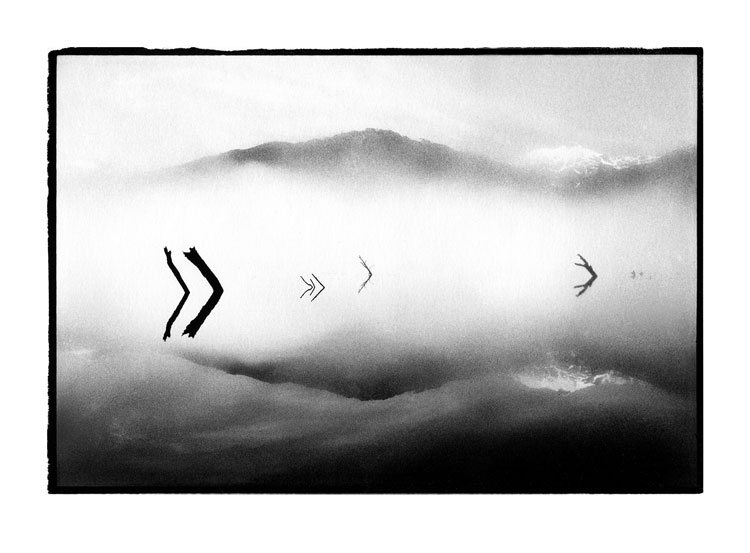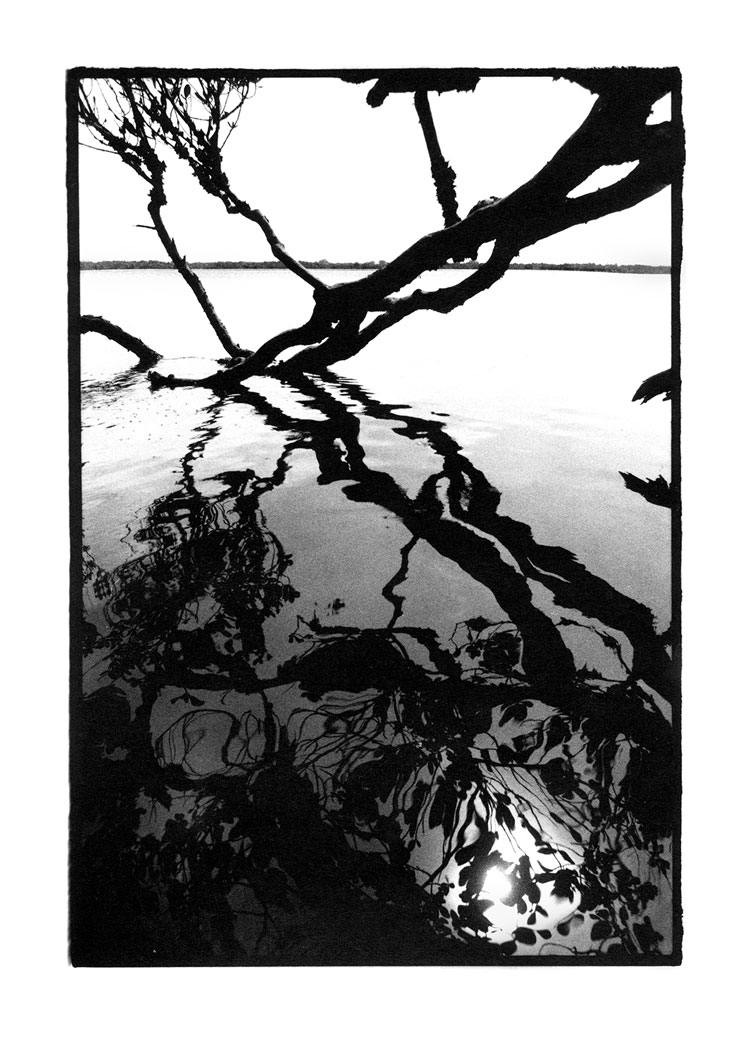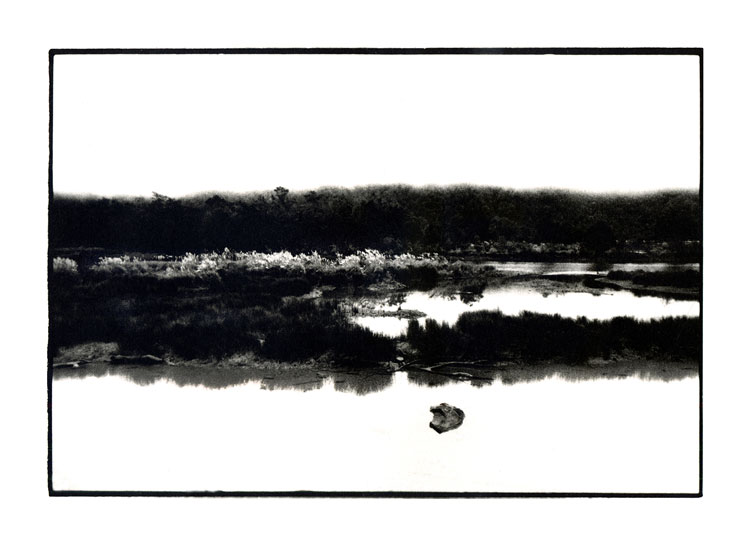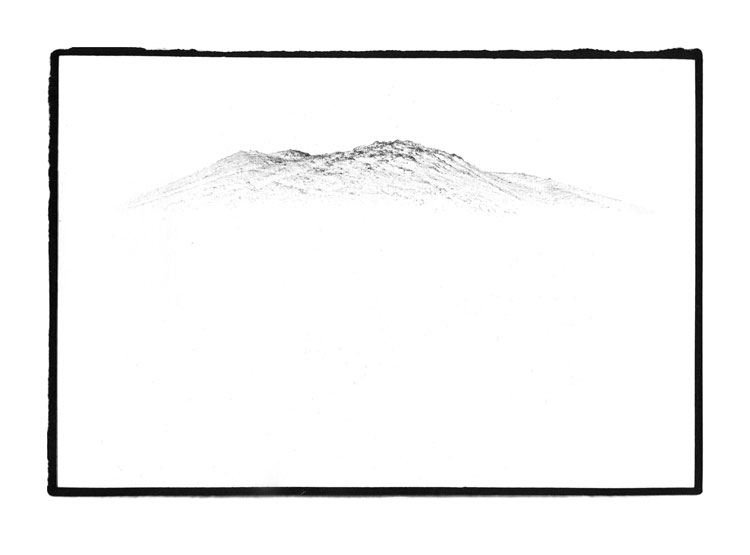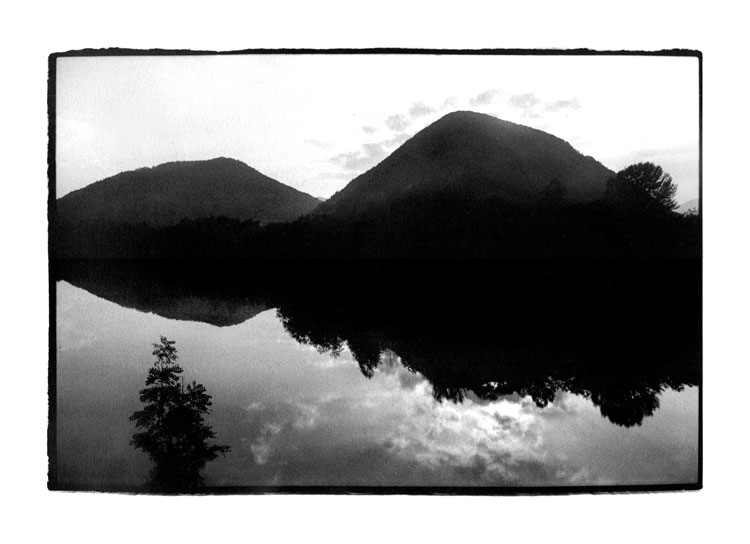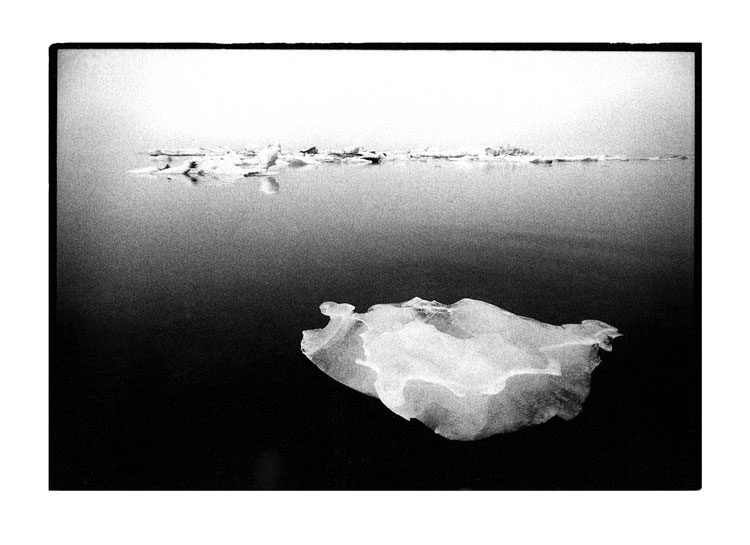

by ANNA McNAY
Toby Deveson (b1971, Milan) was given a Nikkormat camera by his father when he was 16. For more than 30 years, he has been using the same 24mm lens he “borrowed” from his dad. Largely self-taught in photography, Deveson composes his images much as he once composed music: building a solid foundation and a structure with science, before following his instincts. His enigmatic black-and-white images are never cropped. Having started out working in documentary photography, in particular in the orphanages in Romania, Deveson soon discovered his love of landscapes and the “exhilarating relationship” with Mother Nature. His dream is to provoke reaction and move someone to tears with a landscape rather than with a dying child.
[image2]
Deveson spoke to Studio International about his journey – both to places in all four corners of the globe and in terms of his career development – and his desire to leave a legacy.
Anna McNay: Tell me a little about your landscape photographs, which collectively you refer to as West of the Sun. Where does the title come from?
Toby Deveson: It’s taken from a Haruki Murakami book. He is a Japanese author and the book is called South of the Border, West of the Sun, and the West of the Sun bit is very much about how you can never get to the west of the sun. It’s somewhere you can never reach. It’s about chasing your dreams somewhere over the horizon. I thought it was a nice umbrella term for the landscapes themselves. I think the original concept mentioned in the book was about a disease they used to get in Siberian prisoner of war camps, where there was such endless horizon and sky everywhere. The prisoners would be working, and they would suddenly shut down, put their tools down, and just start walking, in a trance. I like the idea of looking for this perfect landscape, looking for the perfect image. Searching for it. It feels very much like that when I take the pictures, the framing of them. Left a bit, right a bit, over there, over there, always on the move.
[image3]
I definitely don’t do the classic landscape, where you set up a tripod and wait for the sun to come up and take three pictures. It’s very quick, very much moving around, running around, taking everything in at high speed. There is definitely a sense of seeking perfection, seeking that world, that place to the west of the Sun. I also don’t crop my images; they are all full-frame negative – the black lines around them are the edges of the negatives. It’s all analogue, so it’s about getting the framing right at the time of taking. Printing is almost secondary. You want to get it right, you want it to look good, and it’s important, but the key to the production is at the time of taking.
[image10]
AMc: When you are out and about and have found a location where you want to take pictures, how many will you typically take? If you are working with analogue, do you have to be more selective than if you were using a digital camera without the associated costs of film and development?
TD: I can’t think about the film or the money. If I’m on a trip, and I’ve got a bag of film, and it starts to run out, then I care, but it depends. I was in Chile in February 2018 and driving past the edge of the Laguna las Torres in the Reserva Nacional Lago Las Torres. It was misty, and I could just see these sticks, these trees, sticking out of the water, so I stopped the car. I was there, I think, for 45 minutes, and I probably took about five rolls of film. Out of that, I maybe got four or five images I wanted to keep. The mist was slowly dissipating. The situation was changing rapidly. I make editions of the prints, 20 in each edition, and I know, for example, that if one sells out, I could probably go back to my negatives and find another image that is different enough, which I could print up. I think five rolls of film is enough.
AMc: Were you in Chile specifically to take photographs?
TD: No, unfortunately. I wish I could afford that. I had a job filming a golf tournament in Chile for a week [Deveson’s “day job” is as a television cameraman], and I asked them to postpone my flight back for another week. I hired a car and took advantage of it. I’ve been on a few trips where it has just been about photography, but they cost, maybe not much financially, but they cost time more than anything – and when you’re freelance, you have to factor in what you’re not earning, as well as what you are spending.
[image5]
AMc: You come from a background as a documentary photographer. How did you make that switch to photographing landscapes?
TD: I have evolved into my art. The varying aspects of my creativity have all evolved separately to match the skills required for analogue photography. I have become a convoluted, complicated, symbiotic lifeform, my photography existing as a separate lifeform within me. But my landscapes sit in a weird space, because they’re not traditional landscapes and, in my head, they are still very documentary.
AMc: In what way?
TD: In the way I take them. My mindset is that of a documentary photographer. It’s been years since I’ve done that kind of work, but I haven’t changed how I proceed. I did a series of photos at the Holi festival in India, just running around, moving quickly and taking pictures as people and things move all around you. Nature doesn’t move around you as much, but you do have to be quick, because of the light. It’s a funny one. I don’t want them to be seen as landscapes, but they are landscapes. I’m proud that they are landscapes, but at the same time …? I think we’ve all got this big red self-sabotage button in front of us. I learned quite quickly how to take good photographs, especially documentary ones. It is difficult though, because you’re having to deal with people and morals. It’s not a case of shooting from the hip and running off. Traditional documentary photography is about telling a story. It’s about getting in deep. It is reportage. It is journalism, and you have to connect. You have to face your own fears and your own insecurities at the same time. You have to search inside yourself while you’re doing it.
[image16]
I did a lot of work in Romania, in the orphanages, but I was also taking landscapes. And that’s where I was happiest. That’s what I enjoyed the most. I won a few prizes and competitions for my documentary work, and, in my head, this was easy, this was brilliant. It’s as if you’re a writer, and you write your first books, and everybody is saying to you: “You’re going to win the Booker Prize. It’s yours. Just keep going, another five books and it’s yours.” And you think: “OK, I’m going to win the Booker Prize, but I’m going to do it with a Mills & Boon novel.” You sabotage yourself. I started wanting that same reaction from people, that people have when you take a documentary picture, to a landscape. But when you have a documentary photograph, you’ve got a story as well.
[image17]
Take the example of a dying child. You’ve got a photograph of the dying child, and, no matter how good the photograph, how well framed it is, how beautiful it is, or whether it’s a work of art or not, people are going to say how good the image is because of the story. What I really hate is mediocre or lazy photographers in a situation where there is suffering, or dying children, or an amazing story, and they come away with crap, but people still go: “Wow, it’s amazing,” because of where they were, not because of what they did. That, to me, is a form of rape. You’re taking advantage of the situation and you’re not putting your soul into it. You can’t take and not give. And if the only way you can give is by creating an amazing work of art, putting all your skills and talent and experience into it, then that is essential for me.
[image18]
It’s the same with landscape. There are so many photographs of amazing landscapes with beautiful sunsets, but they are shit photographs. Nevertheless, people say: “Wow, it’s amazing.” It’s only amazing because they happen to have been on top of a mountain, though. Anyone could have done it, had they been there. So that’s the Holy Grail for me. With a landscape, it’s much harder to impose yourself on Mother Nature. Mother Nature is huge. Mother Nature is an amazing entity, she’s fantastic. You’re having to have a two-way conversation with this huge thing, and it’s a mechanical process. You’re having to let what’s in front of you into the camera, but also put yourself into the camera from behind. For me, that’s a big challenge. The challenge of placing your style and emotions on to something as vast and imposing as Mother Nature. To not be engulfed by her, and to not rely on her to provide you with a stunning image, but to work with her and create something unique from something so universal. I have spent years trying to form such a relationship with her. It’s exhilarating – a relationship infused with wonder and awe, passion and fear. A relationship with an undercurrent of playfulness and power and a constant sense of potential danger.
I wanted to move someone to tears with a landscape rather than with a dying child. Then I wouldn’t have this conflict inside myself asking whether I am doing the right thing. I would feel no shame. I want to provoke reaction, but I want it to be about my work, not just about where I was.
[image8]
AMc: Your pictures are landscapes, obviously, from their subject matter, but, to me, they are absolutely works of art rather than just landscape photography in the straightest sense. There are some which are almost completely abstract, for example, and you wouldn’t necessarily know what you were looking at. And then the mirroring and reflections in a lot of them, and black-and-white nature of them, I don’t see them as landscapes.
TD: Good, nor do I. There is abstraction. They are very traditional in many ways. I use the same lens. I don’t crop. It’s the same film, the same paper. I place many restrictions on myself in order to be able to break the rules within those restrictions. And, for me, the rules I’m breaking are in the composition, the journey your eye goes on, perception. Composition is very important to me. I go on a journey when I’m taking a picture, creating a geometrical pattern in the viewfinder. You almost don’t see what it is. You don’t see the textures or the shape, you just see the overall jigsaw. Then you get back in the darkroom and find that what seemed good at the time just doesn’t work …
[image7]
AMc: Do you return to locations?
TD: Not on the whole, no. I tend to pass through quite quickly. My preferred method, if you like, has become to fly somewhere, if it’s not in the UK, hire a cheap car, shove everything in the back, and just drive. I sleep in the car. Sometimes I spend a week in the car. It depends. I went all round Scandinavia, up Finland, across and down. All around Iceland and Chile. I get the maps out before I go, see where the national parks are and estimate how long it might take to reach them. Then, once there, every now and again I’ll stop and realise it’s maybe about half a day’s walk to get somewhere, so I do that. It’s a nice combination of driving somewhere, slamming on the brakes, jumping out and going: “This is amazing!” – click – and then driving somewhere else, parking, and setting off on foot. Some places are literally two steps away from the car; some of them are half a day’s walk. It’s all about following your nose, following your instincts.
[image12]
AMc: Usually, then, you have an idea of what might be there, what, roughly, you are heading for, but it is not necessarily a specific landmark.
TD: No. You have to be flexible. You have to trust your instinct. It goes back to the communication with Mother Nature. Sometimes the traffic lights change just as you approach, and it puts a spring in your step, and you think: “I’m on the right path. This is where I’m meant to be in my life.” It’s the same with doing this. You have to connect to the energy and go with the flow.
When I went to Scandinavia in 2003, I drove for nine days and covered about 9,000 kilometres. I landed in Oslo and drove to Stockholm. I knew I was going to get a ferry across to Finland. I hadn’t looked up any times, I was quite disorganised. I knew there were a lot of crossings, and I thought it would be fine. I got there towards the evening, and, by the time I found the ticket office, the last ferry, an overnight ferry, was leaving in 10 minutes. The next one would not have been until the next day, and, as it’s a 12-hour crossing, I would have lost a whole day. So, I ran and literally drove on as it sailed off. I then drove up through Finland, which is a beautiful, beautiful country, and the car broke down. I had to wait for two-and-a-half, maybe three hours for the local AA to arrive. Nine days later, back in Norway, I was absolutely exhausted, braindead. It is exhausting taking pictures. I was probably about two hours from the airport, and I had my foot down to catch my flight, when I drove past this lake, Strynevatnet. I saw it go past, and I was driving and looking, but thinking: “No, I’ve got to get to the airport.” But then I slammed on my brakes, reversed, and took a load of pictures. Again, there was morning mist, which means you can get safe pictures – click, click, click. But then you have to ask: “How can I make this a bit quirkier? How can I make it a bit more mine?” You’ve got maybe five minutes at most before it changes. So, on that trip with 9,000 kilometres and nine days of driving, it all led up to this five-minute window.
AMc: At the very end.
TD: It might have been something else if I’d taken another path.
AMc: Is there always water in your pictures? It seems to feature a lot, one way or another.
TD: Not always, but there is a lot of water, yes. You can’t go wrong with it. If in doubt, use some water – with anything. It just gives so much more. It gives reflection, texture, depth. The darkness at the bottom of the frame as well.
[image4]
AMc: Why do you work in black and white?
TD: Because I don’t know how to print colour, simple as that. And I prefer it. My father had all the coffee-table books by Henri Cartier-Bresson, Ansel Adams, Sebastião Salgado. Actually, Salgado was more 80s, just coming in. Josef Koudelka is probably my favourite photographer. He took photographs of the Soviets in 1968 coming into Prague and repressing the revolution. And he took a lot of pictures of gypsies in Czechoslovakia in the late 60s. Beautiful, beautiful work. There is a great documentary about him that was out about three or four years ago. His project now is the wall in Israel. He does big panoramic shots of barbed wire and the wall. The documentary is just of him walking around taking pictures. Nothing much happens, but it’s just so beautiful to see a photographer at work. In the late 60s and 70s, he would walk around Europe with a rucksack, see a bunch of trees and take pictures. His work is wonderful. It’s very raw, black-and-white, beautiful, honest. The framing is very quirky and slightly out, but it works. It’s a small camera, 35mm.
[image9]
AMc: Is that what you use?
TD: Yes, I’ve got an old Nikkormat. It’s a big, heavy, old camera, but it’s a 35mm. I was given it by my father when I was 16, I think, and I’ve been using it ever since. Not the same body, I replace that every three or four years because of wear and tear, but I’ve been using the same lens. I had a couple of cheap lenses, and I found myself using the 24mm more and more. It was actually his lens. I just nicked it, basically.
AMc: Was he a photographer, too?
TD: He worked in advertising. He went to art school. He did magazine layout and design in the late 60s. He then got a job in Milan in about 1970, with the advertising agency McCann Erickson. He and my mother moved out to Italy, and I was born over there. Then we moved around. He got moved to Malaysia, then to Spain, then back to Milan in 1980. I stayed there until about 1991. I went back when I was about 10 and left when I was 19. I came to the UK to go to college. By the mid 80s, he’d left the agency and was working as an advertising film director. So, yes, he used to take lots of pictures. He’d go off and take them, and we would sit and look at the slides.
AMc: You were being influenced from a young age, then. You say you came to the UK to go to college. What did you study?
TD: I came to Brighton to study photography. It was a wasted three years. I had been at the English School in Milan. I did music, art and English A-levels, and I had done my grade eight theory of music when I was 14. I had a good music teacher. I was never any good at playing instruments, but I enjoyed writing music. When I was trying to decide which university or art college to go to, I went to the British library in Milan and looked through the book of courses. The one for Brighton said music and art: 40% music, 40% art and 20% written essays. I didn’t actually apply for the course, I just turned up in Brighton and knocked on the door. I said: “I’m over for a few days from Italy. Here is my portfolio. I’ve got an A. Can I be on your course?” But it turned out that the course was full of the kids from Fame. You had visual arts, and then you could choose between dance, theatre or music. Dance was all about expression, theatre was about being brave, and the musicians were all practical musicians who couldn’t read music but were amazing jazz musicians or rock musicians.
[image11]
I was completely like a fish out of water. I didn’t hate it, it was interesting, and there were some amazing people, but I couldn’t participate. I just spent my time in the little darkroom at the top of the building. After my second year, they started a photography course at Brighton University run by Martin Parr. They had a big facility and studios, a darkroom and everything. But I couldn’t use it. We had a separate building with a small darkroom. I was the only one who used it. I used to pull all my images in the darkroom on my own, and the tutor was very good and let me get on with it. I wrote music when I had to, but otherwise I did photography. So that was sort of a waste. But we had fun. The building got occupied, because they were sacking tutors, and we all went militant and barricaded the building for a week and had big raves in the basements. I played my oboe. There was percussion, and we danced in the dark. It was good fun, but mostly I was in the darkroom.
Before that, though, I had taken a year off after I left school, and that was just when the iron curtain came down and Hungary was the first country to open up. A friend of mine and I decided to cycle there. We got to Budapest, almost went to Romania, but decided to go up to Czechoslovakia instead. After about a month, we got to Kraków. We had to get a train back through to Berlin, East Germany at the time. So, I made my connection with eastern Europe then.
[image20]
When, during my first year at college, the whole thing with the Romanian orphanages and [the country’s communist leader, Nicolae] Ceaușescu was happening, I saw a poster advertising an organisation called Creative Aid for Romania, organising a trip and calling out for anyone who wanted to be involved. What had happened was that an ex-postman from East Grinstead had gone out with a load of teddy bears, trainers and so on, for the children, but had very quickly realised it was pointless, as everything was getting taken by the police, the politicians and the local dignitaries, and nothing was getting to the kids. He decided to do something more tangible and contacted a load of art colleges to take art students out to paint murals as art therapy. Brighton, Sheffield and Wolverhampton said yes. They’d been out twice already before I joined. We basically went to Romania twice a year and, in between times, we raised money. I went and started to take pictures. I had an exhibition in Nottingham in 1991. When I read the comments afterwards, there was all kinds of backlash: “How dare you go out and take advantage of and photograph these poor, dying children.” I thought: “OK, fair enough, you have to make the pictures better.” It was a great learning curve.
I went back three or four times with Creative Aid and worked at different places each time. But you were always in a situation where they wanted to have you there, and kids love having their photograph taken. The first set of pictures I came back with were doe-eyed kids looking up at the camera. The reality was I had been there and had fun. We’d spent our time playing, painting murals and having fun. There was lots of laughter and smiling, so I realised I needed to capture that as well. Not consciously, but I realised I hadn’t come back representing what my experience was. I was trying to force a story, a narrative, on to what the reality was, a stereotype. Every time I went back, I’d come home and have six months printing the pictures and asking myself whether they were good enough. Were they what I wanted? Until you get to the point where they are. It was traumatic. We saw some horrible things. We would go to the Aids hospitals and hospices. But it was also very positive. My degree was mostly pictures from that, but I also took landscapes of the surrounding areas to paint a bigger picture of Romania as a country. I went out there in my final year, on my own with my girlfriend at the time. We borrowed a flat in Bucharest and lived there for three months. I had to get special permission, but my tutors were very good and let me do my own thing. I got some great pictures out of that.
[image13]
On leaving college, there were a good four or five years where I hardly took any pictures at all. I was trying to, but the only thing I really had access to was landscapes. We lived in Yorkshire at the time, so I started learning how to take landscapes, trying to find a voice. That’s the secret of any artist – in photography especially, I think – to find a voice and have a style that you can be recognised for. You want somebody to look at your work and say: “This is by Toby Deveson.” That’s the Holy Grail. It took a while to get that. It became my eternal challenge, and I knew I could go on. I know what I’m doing now. It’s like with the musicians from the 70s, they’re mature now, they know what they’re doing. You just have to remind yourself to keep pushing the boundaries.
AMc: Do you think musical composition plays a role in, or influences, your photographic composition?
TD: Yes, my music was very avant garde, very atonal and arrhythmic. Jarring and jolting. I haven’t heard it for years. I found my old manuscripts a while ago, and I couldn’t remember writing them. I look at them now and think: “Wow, it looks like they were good.” I’d like to go back to that part of me. So, yes, I think it’s definitely in there in my photography. Music is very mathematical and technical, and I’m not mathematical or technical, and yet photography is as well. I find a certain amount of enjoyment in a repetitive task or something that’s logical.
AMc: You talked about the geometry before as well.
TD: Yes, it’s about finding that in a composition, but, at the same time, when I would write the music, I wasn’t sure. I knew what I was doing, but it was very instinctive. You build a foundation and a structure with science, if you like, with knowledge, with experience, and then you use that safety and that solidity to do nebulous things, to follow your instincts, to do something creative. Let’s try this, let’s try that. It’s the same with photography. I don’t know why I pour this chemical into there and this comes out. I don’t know why it looks good. I learned what I needed to know through time and habit. But I’ve missed a lot of stages, a lot of how it should really be done.
AMc: Does that matter, though, if it is turning out how you want it to?
TD: It shouldn’t do, no. It only matters in that it makes me feel like a fraud, but I think most people do anyway.
AMc: It might even spoil what you are doing if you had that extra technical knowledge.
TD: Maybe, exactly. That is basically why I don’t do colour, because you get lazy as well. I got here on a very narrow path, and I learned to do what I do along that path, but to go back to the beginning and learn something new, I’m too old for that. Plus, I’ve never seen a colour landscape or colour photograph that has wrung my heart out and made me want to do that.
[image14]
AMc: Do you think it would take some of the art away?
TD: Yes. It’s about being jealous. It’s about looking at other people’s work and being green with envy and ripped apart inside because you are jealous of it. You want it to be yours. If I see that in somebody else’s photograph, then I try and emulate it. I occasionally do portfolio reviews, and that’s what I say: “Look online, find other photographers who speak to you, who move you to tears and rip you apart inside, and look at their photographs, sit and look at them and understand why they do that. Once you’ve got used to that feeling inside of that connection with an image, once you’ve understood that muscle and how it works and why, then you can apply it to your own work. Your judgment of your own work is so clouded. It’s mixed in with the memories of what you did. The only way of being able to judge it yourself is as if you were seeing it through the eyes of a stranger.”
AMc: Another reason why colour wouldn’t work as well in your pictures is because they are very much about contrasts of light and dark, or they seem to be. The extreme white and the shades of grey and black. Would you lose that powerfulness in colour, because there would be too much detail?
TD: Yes, exactly. You can get away with it in black and white, completely burnt out or just a hint of grey. In colour, it’s just going to look a bit bleh.
AMc: People are always trying to heighten certain aspects of colour.
TD: I have great fun doing that, actually. I take pictures on my phone, and I love the garishness and the colour. My kids are growing up, and it’s like the iPhone is doing the work that Kodak and the Box Brownie once did. It’s very similar in that you haven’t really got a zoom. You have to move and frame, and it’s the same sort of thing. It’s brought a joy back to some things, spontaneity and fun. There were times when you did that with your camera before digital cameras, taking pictures of your pets, your family, or whatever. Then you had to wait to get them printed.
AMc: I remember that. You never knew what you were going to get back.
TD: Exactly. It’s hard work for me now to go to the darkroom. It’s a real love-hate thing. The fun is in the taking, that’s the easy bit. If you go away and come back with 90 rolls of film and you see the negatives, you think: “I’ll print that one and that one.” But you shouldn’t print anything until you’ve done the contact sheets. There has to be a balance between discipline and child-like abandon and enthusiasm. Cataloguing, notes and storage also play an important part in being a photographer. Is a photographer a mad scientist, chaotic artist or an anal control freak? Or a wonderfully infuriating combination of all three? Contacts are the backbone of a photographer’s work, the foundation around which the darkroom functions. Without them you will struggle to remember which frame you used when you return to reprint an image, assuming there are a few that are similar. You can write printing notes on them, number the page and frame for cataloguing, and go through your images again and again without fear of damaging the negatives. When it comes to the moment of printing contacts, I know I struggle to find the will power and discipline, but it is a chore that must be done. Years of experience have taught me that I never regret doing them, yet always regret it if I don’t. Sometimes it’s hard to find the joy in it though. It gets tiring. It’s been 30 years since I took my first usable landscape. That’s a lot of emotional baggage. A lot of failures. A lot of rejections. A lot of memories. Print-wise, again, I’m self-taught through instinct and observation. It’s about the journey the eye makes. I rarely get it to print right first time, maybe the second time if I’m lucky. The things I consider wrong are usually very subtle. Black and white can get a bit dirty sometimes.
AMc: Is that to do with how long you expose the print for?
TD: Yes. It’s like conducting an orchestra of light – another connection with music. You are dodging and burning and building up the light. Denying the paper the light. Going round and round. It’s all instinctive. You’ve got the clock ticking away and you know you’ve got 30 seconds or a minute to get it right. Getting it right is difficult. It is important. I’ll do a print, and it’s not quite right. Then, seven or eight prints later, it’s still not quite right. I hang them all up, and it turns out that first one was perfect after all. I think that’s probably characteristic of a lot of my work: the pictures are frequently slow burners. They’re not high impact, I don’t think. They live with you. Over time, they talk to you, and you see different narratives, and they talk to each other. Michael Kenna’s work is maybe a little bit similar, but there aren’t many photographers like us around. People want sales. They want success. They want exhibitions. But, above all, I think you want a reputation, you want respectability or acknowledgement from your peers. I want to leave a legacy. That’s one of the key things I strive for.
• For more information, see tobydeveson.com.
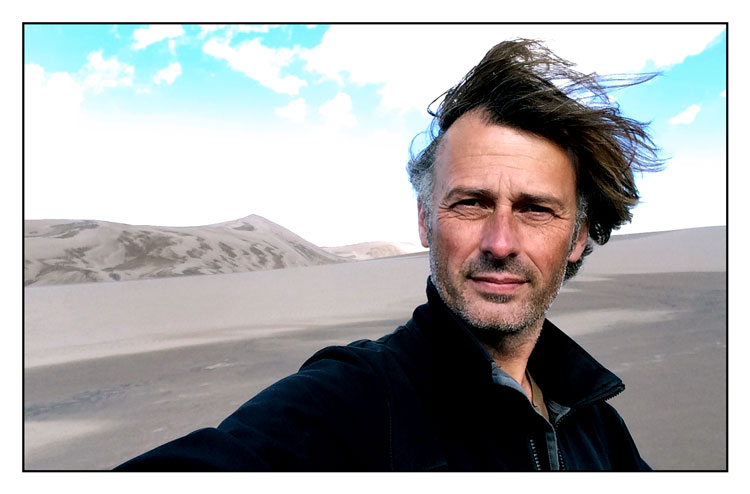
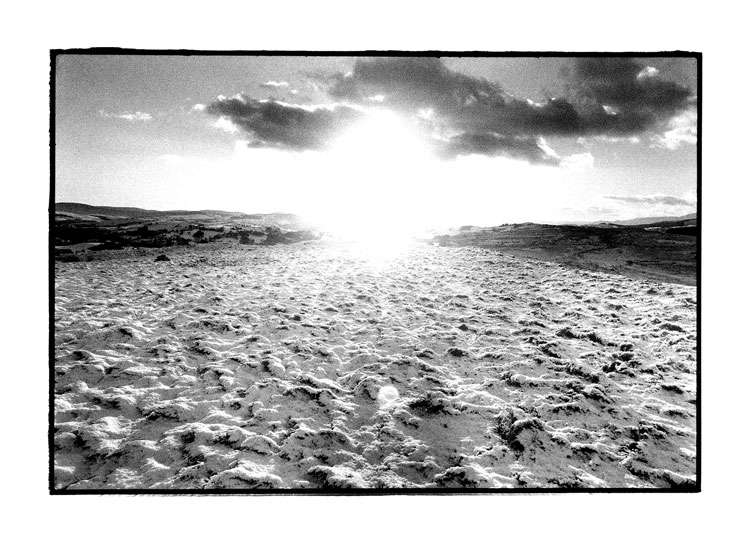
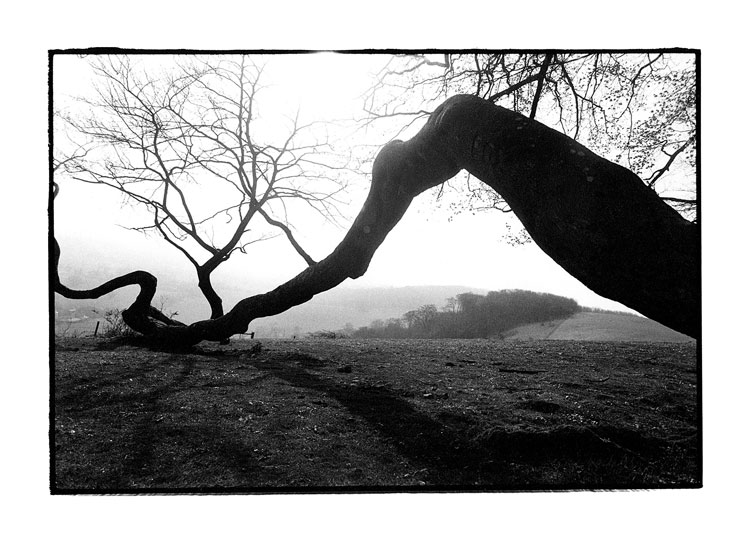
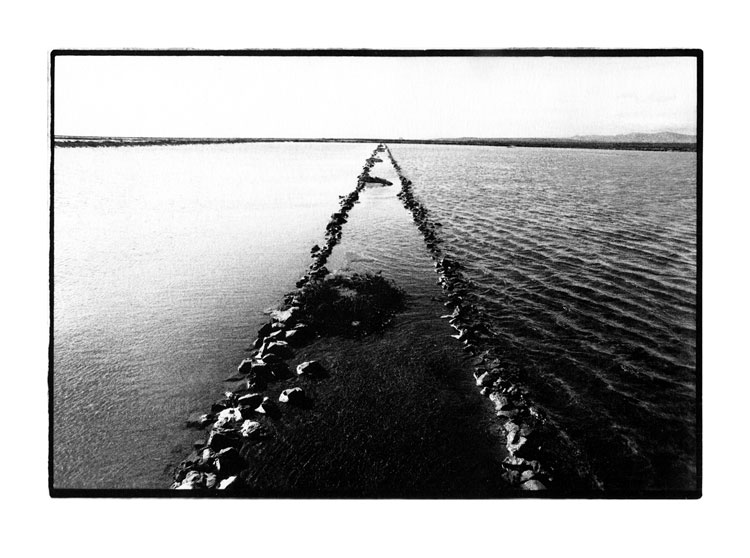
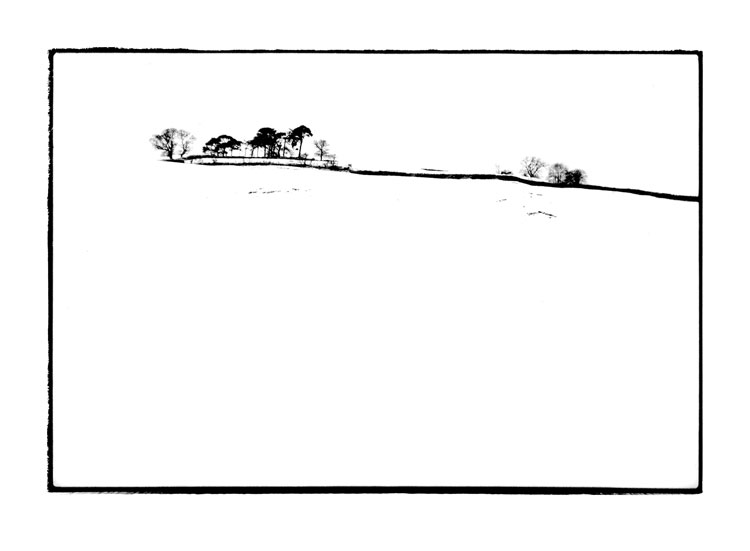
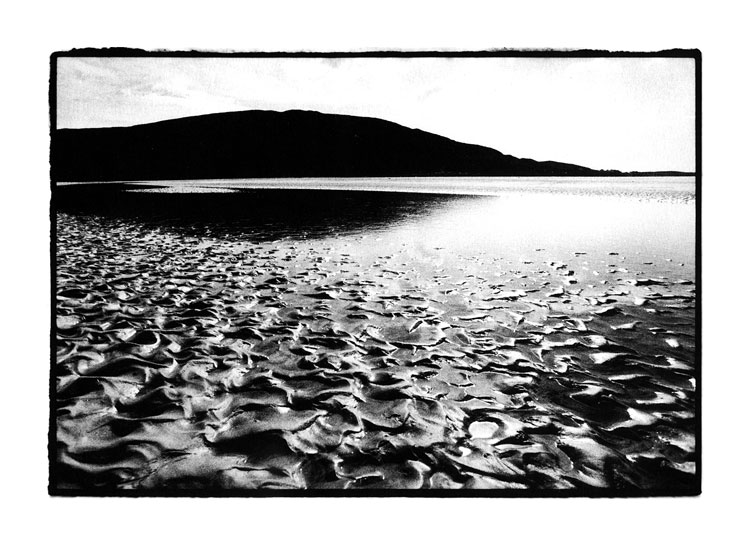
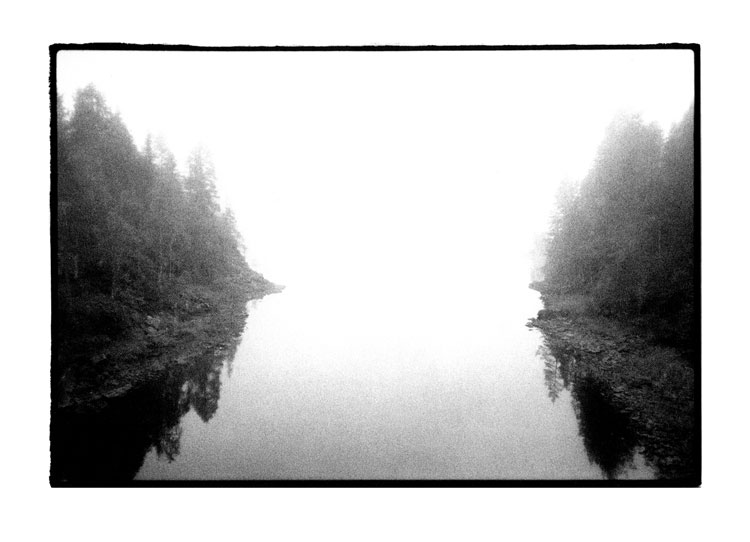
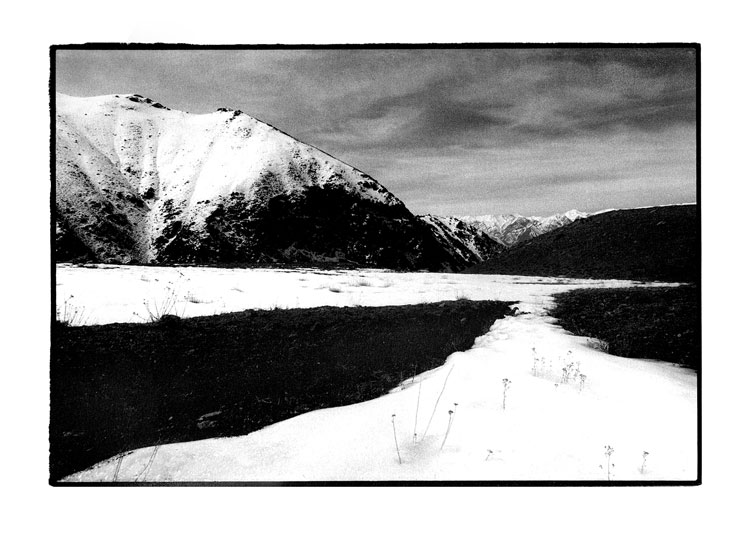
.jpg)
